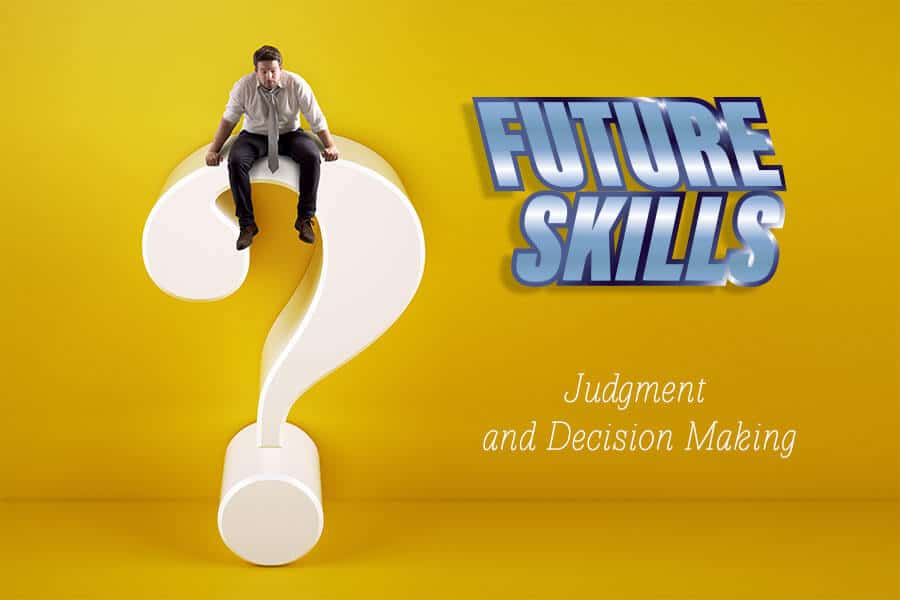With the rise of automation comes the rise of soft skills. The landscape of work is shifting, and in order to keep up with the change, workers need to develop competencies that machines won’t tackle. In this series we talk about the top 10 soft skills that will help you to thrive in 2020. And today’s skills are judgment and decision making.
The Role of Judgment in Decision Making
Judgment is an ability to make weighed and effective decisions, come to sensible conclusions, and form objective opinions.
The popular Myers-Briggs test distinguishes judging as one of the components of C.G. Jung’s behavioral theory, in addition to being an extrovert/introvert and using logic or feelings in the decision making process.
According to the test, individuals who have a judgment component that prevails over the perceiving component tend to structure the reality around them.
They appear to be task-oriented, avoid missing deadlines, and like to get things decided.
If you consider judgment a skill, you can easily practice it and get better at it.
Some of the techniques of improving judgment include avoiding questioning your decisions and sticking to them despite excuses.
It is more manageable to improve judgment on a smaller scale when the stakes are low.
For example, ordering a new meal is a low impact decision which helps you to get comfortable with the unknown.
And in case you don’t like what you ordered, it’s not going to impact your life in the long term.
You can divide decisions into the ones you can take back and the ones you can’t.
If you know that you can go back on a decision and try again, there is no need to dwell on it and be indecisive.
On the other hand, if there is no coming back after committing to a decision, you may want to consider getting equipped with techniques on overcoming analysis paralysis.
Overcoming Analysis Paralysis
Analysis paralysis is a state in which an individual gets overwhelmed by a situation and can’t move forward thanks to an inability to make a decision.
It usually happens because there are too many options to choose from or too much information to navigate through.
Analysis paralysis becomes a problem as it prevents one from making decisions fast enough.
Here are a few tips on what to do when you find yourself calculating and hesitating a bit too long on a problem.
Differentiating Between Big and Small Decisions
Ask yourself three questions i:
- How important is this decision?
- Will this impact me a year from now?
- What’s the worst thing that could happen?
How important is your decision?
If there are no serious consequences that will come out of the decision, then there is no point in spending more time than the issue is worth.
Minor short-term decisions won’t matter in the grand scheme of your life.
Decisions in this category could include things like choosing an outfit or deciding on a meal in a restaurant.
However, if it is a major decision such as buying a house or getting married, you may want to set aside some time to create a step-by-step outline and weigh the pros and cons.
Avoiding Impulsive Decisions
If we don’t plan for things, we may be caught off guard when it comes to making a quick decision.
And depending on the consequences, you may want to have a few techniques up your sleeve for when you feel an urge to make a decision impulsively.
Pausing and Giving It Some time
If the decision at hand is not an urgent one, ask for some time to think.
This will help you to get a better understanding of your resources and the potential outcomes as well as preventing you from spreading yourself too thin.
Writing down the facts
To see the consequences of each alternative decision clearly, structure your thoughts and write down the facts for each of them. You may want to create a personalized template.
Discussing options with a trusted colleague or a mentor
When we are immersed in a stressful situation, it is important to seek an objective opinion from someone more experienced.
Share your ideas with someone whose track record includes a history of making high-stakes decisions and look at all angles to find a better strategy.
Understanding your motives
Reflect on what’s driving you, what’s your incentive for a decision.
Understanding your feelings and expectations will help you to judge whether the decision you are about to make will lead you to the desired outcome.
Additionally, reflecting will help you to find alternative options for reaching your goal.
Making recurring decisions automatic
Albert Einstein and Steve Jobs were known for having signature outfits which they wore on most days.
For Einstein it was a variation of gray outfits, and for Jobs it was a black turtleneck and jeans.
This approach of making certain decisions automatic allows people to save cognitive power and use it on more important tasks.
Here are some ideas to help you get rid of unnecessary recurring decisions.
Think of how to eliminate some of the unnecessary decisions
- Find a few shirts, jeans and other pieces of clothing that fit you well and buy multiples of them.
- Set a time to exercise every day and commit to it.
- Do your grocery shopping on the same day weekly or subscribe to a delivery.
- Design a morning routine that may include exercising, meditation, goal setting, daily journaling, breakfast, commute, etc.
- Meal-prep in advance or create a meal schedule for a few weeks.
- Automate utility bills and savings payments.
- Set up Google calendar reminders for recurring doctor appointments.
- Pick a day every month for a nail/hair appointment.
- Make it a habit to book a date with your partner/family for quality time together.
Apps to Help in the Decision-Making Process
In addition to tree diagrams and step-by-step plans for decision-making processes, put technology to good use.
Use the apps below to help weigh the pros and cons of upcoming decisions and organize all the details in one place.
Decisionize
This app allows you to break down the thinking process into three steps and then evaluate your decision in the end.
First you write down all the choices you have, and then you list all the pros and cons that accompany your decision.
The final step is the most exciting one as the website presents your data in a series of questions which will help you to determine the best alternative.
Pros & Cons
This app for your Android helps you to create a list of pros and cons which you can then rate on a 10-point scale (from “not important” to “very important” for pros and from “not bad” to “very bad” for cons).
Once you have listed as many pros and cons as you can think of, the next step is to tally the results depending on the weight of each item on your list.
Pollsify
Pollsify is an app that creates shareable polls to collect opinions from your subscribers or coworkers.
You can create both public and private polls and attach a GIF or an image or pin a location in addition to adding a question.
Polls can be two types: multiple choice texts or emojis.
Decision making skills are extremely crucial when it comes to managing your time and choosing a career or educational path.
If you’d like to get more background information on methods and techniques for making better and faster decisions, here is a Decision Making Scenarios course, designed to explain applying quantitative models to better business decisions.
Additionally, the University of California is offering a course on effective problem-solving and decision-making with a focus on critical thinking.
Being comfortable with making decisions and moving on guilt-free will help you to get ahead in less time.
Photos: Shutterstock / Edited by: Martina Advaney
Check out the other articles in the series of Top Future Skills:
More about decision making you can read on our Magazine.
The Top 10 Future Skills: People Management and Coordination
Support us!
All your donations will be used to pay the magazine’s journalists and to support the ongoing costs of maintaining the site.
Share this post
Interested in co-operating with us?
We are open to co-operation from writers and businesses alike. You can reach us on our email at [email protected]/[email protected] and we will get back to you as quick as we can.













